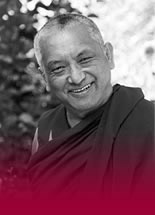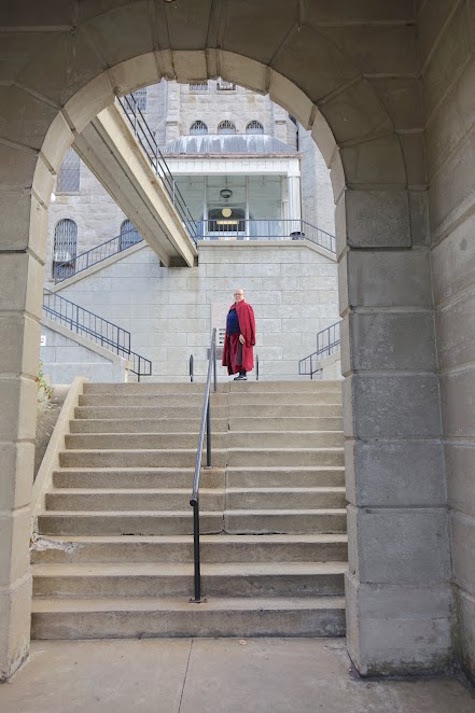Travel Blogs
22 November, 2015 | United States
We finished our weekend course at Shantideva in New York early on Sunday evening, November 8, in time to catch a flight from LaGuardia to Nashville. The flight left three hours late and John Flandrick, whom I’ve known from the Bay Area since I lived there, picked me up at 11pm. He’d come especially from Santa Barbara to be my driver. We spent the night at a motel on Highway 24, then drove to Eddyville for an 8am visit with Mitch Willoughby at Kentucky State Prison. At noon we drove six hours to eastern Kentucky, to the University of Pikeville: “the leading university of Central Appalachia.”
I’ve been coming to Eddyville since 1997. An inmate there, Ralph Ospalski, wrote to our center in Washington DC and asked for someone to visit him. The message got to me and I went. Ralph has been moved to another Kentucky prison now – preparing himself for parole; good for him! – but since then I made contact with Mitch Willoughby on death row.

Mitchell Willoughby, on death row in Kentucky; a piece of Mitch’s handiwork.

I had a couple of hours with Mitch, in a room next to the chapel. He’s doing beautifully: he practices and studies every day, writes to his family, spends time with his friends on death row, and makes little things to send people. Pictured here is a little box that he made for my sister in Melbourne, Julie, who designed a nice certificate showing Mitch’s credentials that he wanted to offer his parents. He helps many people, in fact.
Outside Kentucky State Penitentiary. Photo John Flandrick.
There’s a clichéed idea that when you help people in prison you’re helping them to prepare to rejoin society when they’re released. But so many people will never be released, certainly in the US. According to a report I just read on projectcensored.org, in 2012 there were something like 160,000 people in US prisons serving such sentences, an increase of more than 20 percent since 2008, and nearly 50,000 of those have no possibility of parole. And according to Wikipedia, as of January this year, there were 3,000 people on death row. People in prison are part of “society” too! By giving one person tools to help themselves, their mind, they are able to help others around them. That’s pretty evident.
I remember when I was involved in radical politics, in London, in the early 1970s, working with a group called Friends of Soledad, which supported George Jackson and the Soledad Brothers (Postcard 7), I had these sweeping grand ideas about revolution, changing the world. Giving one book to one person doesn’t sound very revolutionary! But I’ve realized over the years as a Buddhist that clearly you cannot bash the world into shape; grand political gestures are necessary, but helping one person, who in turn can help another, is a powerful way to bring change – to help people change their minds. Change can’t possibly be imposed.
The vast majority of people in prison whom I’ve met have no money, no resources, few friends, so one book can be such a treasure. On the outside, we have bookshelves of books, so many of them unread. My friend in prison in Michigan, Timothy Haremza, told me when he first wrote in the 1990s that his copy of one of Lama Yeshe’s booklets was “worn thin” from being passed around and read by so many people. Over the years LPP must have sent scores of thousands of books to thousands of people of prison. It seems to me that if one person even just reads the words that they can change their mind, that they have potential: that’s revolutionary. As Lama Zopa Rinpoche said once in relation to the practice of generosity, you could give food to every person on this planet – incredible generosity; but the action of giving just one piece of spiritual advice to one person is superior in terms of the merit created and the benefit, because that can help them over countless lives and thus help them to help others. Whereas offering food only helps the body. (Of course, we can do both.)

At the office of Friends of Soledad in London in the early 1970s (lighting one of my 60 Marlboros a day): using very different methods to help people in prison!
A dear man called Robert Musick, a chaplain and instructor of religion at UPike, had invited me to give two evening talks on engaged Buddhism. I’d never been here before. Such nice people! And the university is booming, bringing people from around the world, I was told.
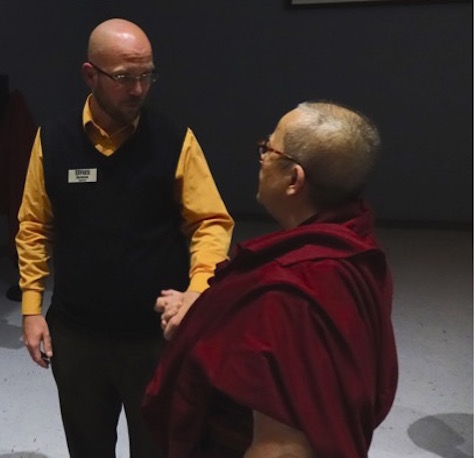
Chaplain Robert Musick of University of Pikeville. Photo John Flandrick.
I had a very nice conversation one morning with the chaplain and various other Christians at the university. What fascinates me is the variety of interpretations existing comfortably side by side in the churches now. When I was a kid in Melbourne in the 1950s you had the Catholics, the Anglicans, the Presbyterians, and the Methodists, and maybe a Baptist or two. I didn’t hear much about the other, smaller, churches. And you wouldn’t have dared to step outside the traditions of your church!
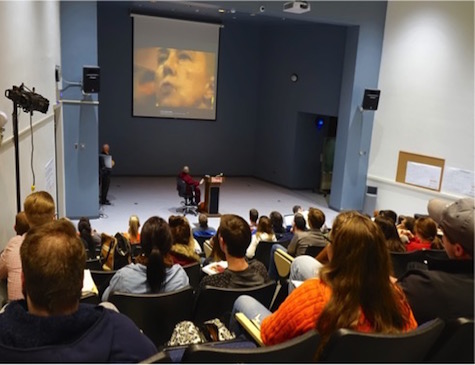
They showed Chasing Buddha before the talk at UPike. Photo John Flandrick.
On Thursday November 12 I flew to San Francisco. I’d spent years here, either driving up regularly from Santa Cruz since 1994 or being based here with LPP until 2008, but I never felt really at home in the place. People rave about certain cities, and SF is certainly one that has a big reputation. But I could never find the San Francisco that people think is so fantastic! I remember when I lived on Webster Street, when LPP was at Tse Chen Ling, I’d go out in an evening for a walk. I’d be on the street, deciding which direction to go in. I’d think, okay, I’ll go north; no. I’ll go south, no, nothing there. East? Same answer. Nothing grabbed me. Beauty, for sure, is in the eye of the beholder!
I gave a talk at the San Francisco Zen Center on Page Street, not far from where Tse Chen Ling used to be. I admire these people! They’ve been going for 40+ years, it seems, and have many projects, and have helped many people over the years.

Here’s the blissful Kwan Yin at the Zen Center; she greets you in the lobby.
Tse Chen Ling moved from Webster Street several years ago and is now in a former church on Jules Avenue, 10 miles south, in Ingleside. I attended a teaching of Geshe Dakpa’s there the evening I arrived: a long time since I’d done that. Besides being a scholar and a yogi, Geshe-la is also an astrologer: one of the five sciences studied in the Tibetan monastic university system. I remember years ago Lama Zopa Rinpoche said that Geshe-la is “the best astrologer on the planet.”

Geshe Dakpa and Geshe Rabten: both rock-like in their demeanor.
I love Geshe Dakpa. He’s like a rock, a mountain. He always looks very stern, like in this photo, but apparently he’s hilariously funny! Michelle Stewart, who was director of Tse Chen Ling when I was there, would serve as the lamas’ driver when they were all in town for, say, His Holiness’s teachings, and she said that sometimes Lama Zopa Rinpoche and the others in the car would be hysterical with laughter at things Geshe-la would say.
He reminds me of Geshe Rabten, one of Lama Yeshe and Rinpoche’s gurus from Sera Je. He had the same, stern, rock-like demeanor, as if you could trust him with your life. I loved him too. And I bet he was funny as well! There’s no doubt that when you’ve gone beyond ego, you’d definitely be funny. As Lama Yeshe said one time, having found the truth, Milarepa was “up in the mountains, laughing!” I can’t wait!
Then to Vajrapani Institute in Boulder Creek, in the redwoods, an hour from Santa Cruz. As I mentioned in Postcard 18 and others, this was the center where I first worked when I came to the US in 1994. But it wasn’t my first time here: that was 10 years earlier, for Lama Yeshe’s funeral.

Lama Yeshe, in India in the early 1970s. Photo Brian Beresford.
That was an extraordinary time. I’ll never forget it. I was working for Wisdom Publications at the time, in London, with Nick Ribush. We all knew that Lama had a bad heart, but of course you can’t bear to think of him passing away. We got the news on the day Lama died, at dawn on Saturday March 3, in California. That was around lunchtime for us in London. People were not necessarily advised to come, but we decided immediately that we would go to Vajrapani, where it was already agreed the ceremonies would take place.
No Internet in those days, but we had a kind travel agent who took care of things for us. At the time I was working on the second issue of a magazine called Wisdom. The first one came in in 1983 and celebrated Lama’s visit to Tibet the year before, as well as reporting on events at FPMT centers worldwide. Basically, it was the forerunner of Mandala Magazine. It was published by Wisdom Publications (Mandala is published by FPMT International Office). We had determined to publish one annually and give it away for free. I was working on that second issue when Lama passed away.
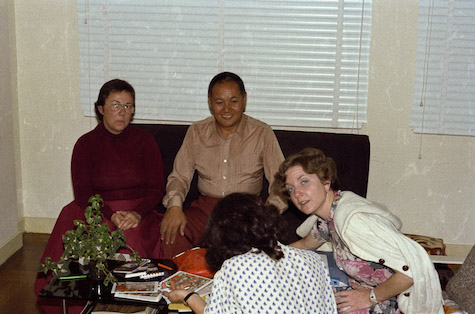
With Lama and Jacie Keeley, right, and Nicole Kedge in Hong Kong soon after Lama got back from Tibet where, of course, in those days, 1982, it was necessary to go incognito. Our first issue of Wisdom reported on the visit. Photo Lama Yeshe Wisdom Archive.
(We started the magazine because Lama had wanted it. After the First Dharma Celebration in 1982, organized by Lama in India, at which hundreds of us received teachings from the greatest lamas for six months, Lama told his secretary Jacie Keeley that he wanted us to put out a magazine and to call it The Propagator. Lama and his wonderful names for things! Lama wanted it to be ready for the tour of His Holiness in Europe later that year; Lama had invited His Holiness to give several teachings in France, Spain, and Italy. Anyway, there was no time then: there were just a few months between the end of the Dharma Celebration and the beginning of the European tour, and I spent that in Hong Kong printing several Wisdom books as well as an FPMT brochure in five languages, a poor substitute for a magazine, but something to hand to people nevertheless. And when we finally got to do it the following year we just couldn’t bear to call it The Propagator – we decided on Wisdom instead: English for “Yeshe.”)
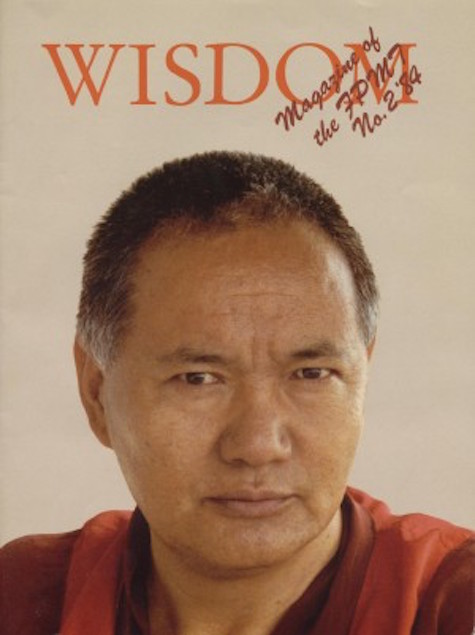
Photo Ueli Minder.
With Ven. Yeshe Khadro and Ven. Ann McNeill at Vajrapani at Lama’s funeral, March 1983. Photo Ricardo de Aratanha & Lama Yeshe Wisdom Archive.
Anyway, we were at Vajrapani for more than a week. Hundreds of people turned up from all over the world. I am so so glad I was there. After I got back to London I had to pick up work on the magazine again, and what else could we feature but the life and death of Lama Yeshe? It took months of work: so wonderful, but so painful, too.
You can read many of the articles from the magazine here: lamayeshe.com/article/tribute-lama-yeshe-1935-1984
We used the above photo of Lama, taken by Ueli Minder, because the Australian monk Ven. Gyatso told me that when Rinoche saw that photo he said, “Everyone should have a copy of it.” In my opinion, it conveys perfectly the wrathful compassion of Buddha Heruka Chakrasamvara, Lama’s yidam.
The magazine came out a year after Lama passed away. Here’s me at Tushita in Dharamsala, taking a break from my retreat, in February 1985.


